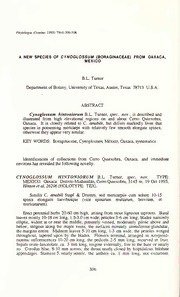
A new species of Cynoglossum (Boraginaceae) from Oaxaca, Mexico PDF
Preview A new species of Cynoglossum (Boraginaceae) from Oaxaca, Mexico
Phylologia (October 1995) 79(4);306-308. A NEW SPECIES OF CYNOGLOSSUM (BORAGINACEAE) FROM OAXACA, MEXICO B.L. Turner DepartmentofBotany, UniversityofTexas, Austin,Texas 78713 U.S.A. ABSTRACT Cynoglossum hintoniorum B.L. Turner, spec, nov., is described and illustrated from high elevational regions on and about Cerro Quiexobra, Oaxaca. It is closely related to C. amabile, but differs markedly from that species in possessing mericarps with relatively few smooth elongate spines, otherwisetheyappearverysimilar. KEY WORDS: Boraginaceae, Cynoglossum, Mexico, Oaxaca, systematics Identifications of collections from Cerro Quiexobra, Oaxaca, and immediate environshasrevealedthefollowing novelty. CYNOGLOSSUM HINTONIORUM B.L. Turner, spec. nov. TYPE MEXICO. Oaxaca: DistritoMiahuatlan, CerroQuiexobra, 3145 m, 19 Oct 1995, Hintonetal. 26206(HOLOTYPE: TEX). Similis C. amabili Stapf & Drumm. sed mencarpiis cum solum 10-15 spinis elongatis laevibusque (vice spinarum multarum, brevium, et muricatarum). Erectperennial herbs 20-60 cm high, ansing from stout ligneous taproots. Basal leavesmostly 10-18cm long, 1.5-3.0cm wide; petioles3-6 cm long; blades narrowly elliptic, widest at or near the middle, pinnately veined, moderately pilose above and below, strigose along the major veins, the surfaces minutely atomiferous-glandular, themargins entire. Midstem leaves 5-10 cm long, 1-3 cm wide, the petioles winged throughout, tapered upon by the blades. Rowers terminal, arranged in scorpioid- racemic inflorescences 10-20 cm long, the pedicels 2-5 mm long, recurved in fruit. mm Sepalsovate-lanceolate, ca. 3 long, stngose externally, free to the base or nearly so. Corollas blue, 8-10 mm across, the throat nearly closed by hispidulous bilobate appendages. Stamens 5, nearlysessile, the anthers ca. 1 mm long, not excurrent. 306 Turner New Cynoglossum from Oaxaca 307 Figure 1. Mencarps ofCynoglossumamabile (lowerleft, Webster 11327 [TEX]) and C. hintoniorwn (uppernght, from holotype). A 308 PHYTOLOGI October 1995 volume79(4):306-308 Styleca. 3 mm long, the stigmaticsurfacemoreorlesspeltate. Mencarps(3 of them), each with 10-15 long flattened smooth spines, 3-4 mm long, their apices with 2-4 hooked hairs, 1 ofthe mericarps tending to abort, nearly rugose, not at all spmose or very weakly so. ADDITIONAL SPECIMEN EXAMINED: MEXICO. Oaxaca: Distnto Miahuatldn, Xianaguilla, 2715 m, oak and pine forest, 13 Oct 1995, Hinion et al. 26063 (TEX). Thistaxonhas most of the characters of Cynoglossum amabile Stapf & Drumm., exceptforthemarkedlydifferentfruits,as shownin Figure 1. Examination of 30 or moresheetsofC. amabile(LL,TEX) from bothMexicoand Central America revealed nofruitsremotelyapproaching thoseofC. hintoniorum. Mexico is now known to have four species of Cynoglossum. C. amabile, C. henricksoniiHiggins (=C. erectumHiggins 1976, not C. erectum Sweigg ex Schrank 1822), C. hintoniorum, and C. pringlei Greenm. Cynoglossum atnabile is said to be native to China, being introduced into Mexico and elsewhere in Central and South America (c/. Nash & Moreno 1981, who provided an excellent illustration). Brand (1921), however, does not note a New World distribution in his treatment. Apparently C. amabile is used as a folk medicinal, having largely spread throughout the tropical and subtropical regions of the New World over the past 50 years (it was not described as new to science until 1906). Gibson (1970) thought the plant to be largely cultivated for ornamental purposes in Guatemala, the very adherent seeds readily dispersed by mammals, including man. Finally, it should be noted that C. hintoniorummaybeastabilizedor populational fruit-form of C. amabile; if so, it is a remarkable populational variant, especially since it occurs at two distant locales in Miahuatl^ at very high elevations (2715-3145 m) in regions relatively remote from human populationcenters. ACKNOWLEDGMENTS I am grateful to Gayle Turner for the Latin diagnosis, and to her and Ted Delevoryasforreviewing the manuscript. MarciaThompsonprovided the illustration. LITERATURECITED Brand, A. 1921. Cynoglossum, in PHanzenreich IV (252):114-153. Gibson, D. 1970. Cynoglossum, in Rora of Guatemala. Fieldiana: Bot. 24:133- 134. Nash, L. & N. Moreno. 1981. Cynoglossum, m Rorade Veracruz. 18:52-55.
